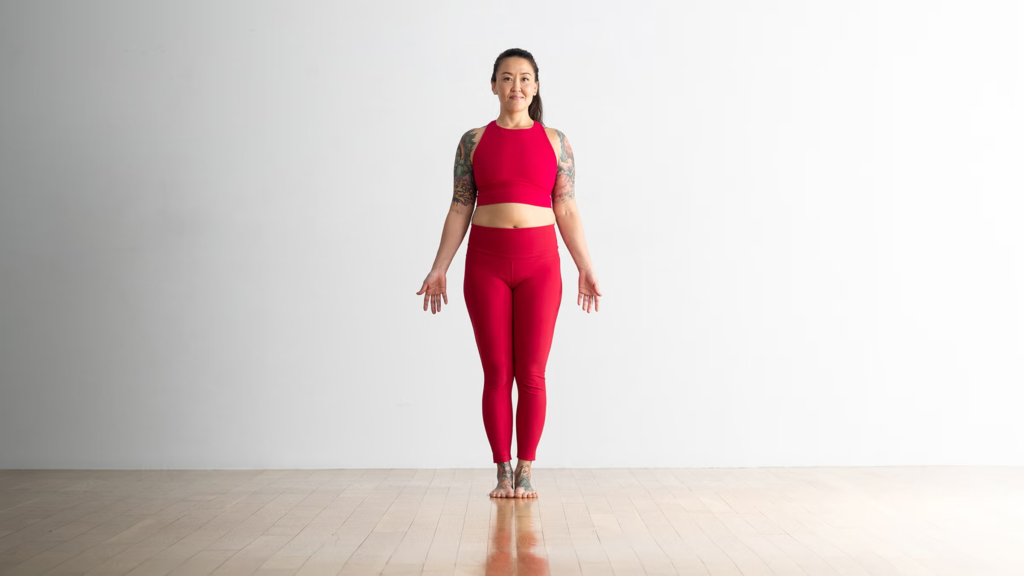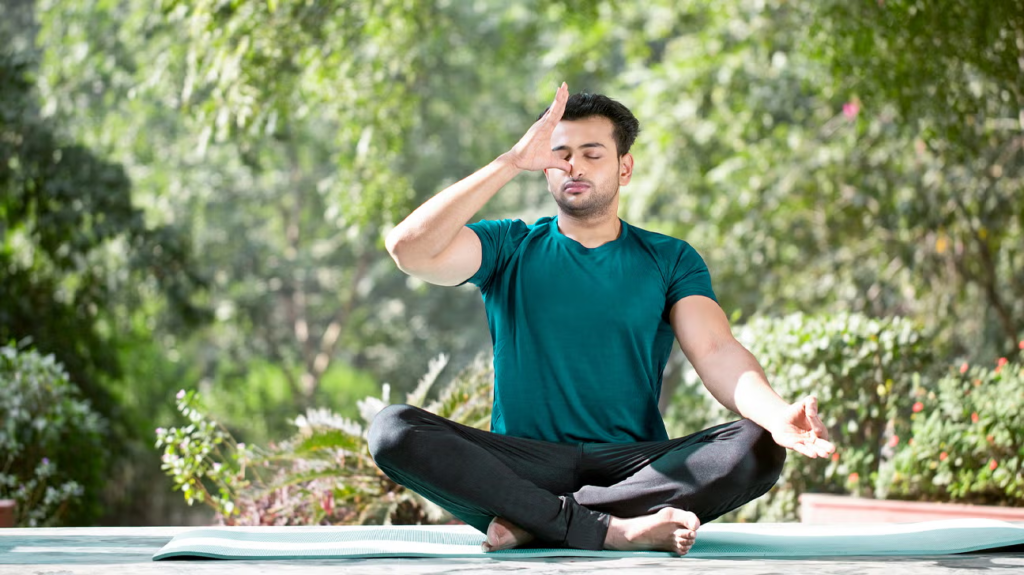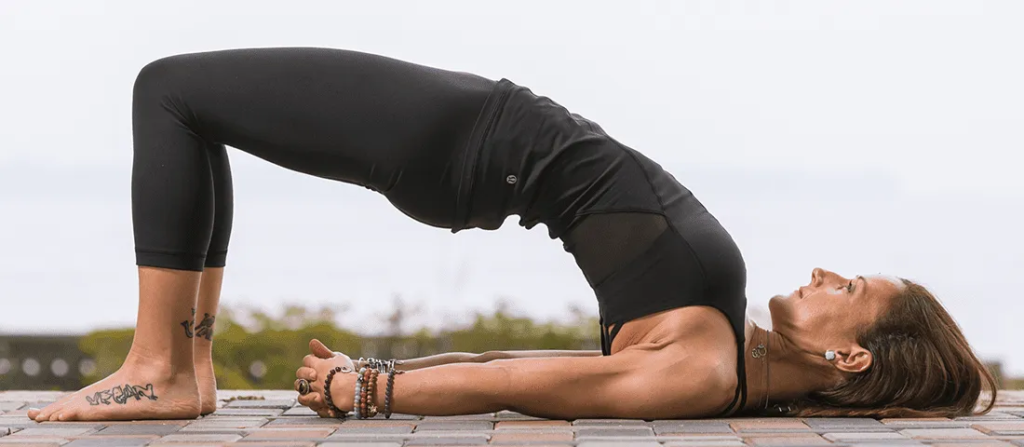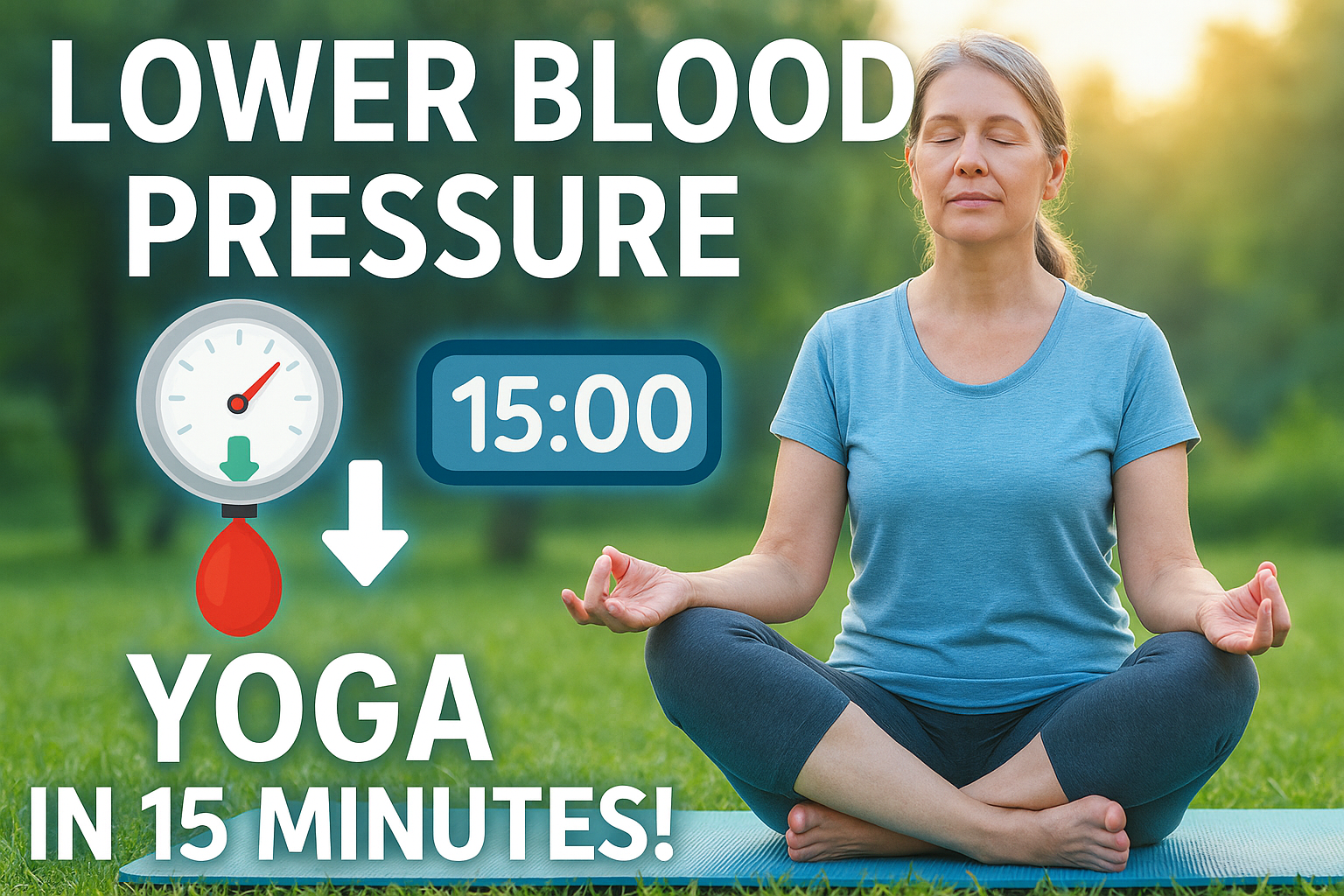High blood pressure, also known as hypertension, is a common health condition that affects millions of people worldwide. When left unmanaged, it can lead to serious complications like heart disease, stroke, and kidney problems. While medications and lifestyle changes play important roles in controlling blood pressure, ancient practices like yoga offer a natural, holistic method to help lower it. This article explains how a focused 15-minute yoga routine can support blood pressure management, delves into the science behind the practice, and provides detailed instructions for safe, effective poses that anyone can do—even if you’re new to yoga.
Understanding High Blood Pressure
What Is High Blood Pressure?
Blood pressure is the force exerted by circulating blood on the walls of the arteries. When this force is too high, it can damage blood vessels and organs over time. Hypertension is often called the “silent killer” because many people may not notice symptoms until significant damage has occurred.
Causes and Risk Factors
Several factors contribute to high blood pressure, including:
- Stress: Prolonged stress increases cortisol levels, which can raise blood pressure.
- Diet: High salt intake, poor nutrition, and excessive alcohol consumption are known risk factors.
- Sedentary Lifestyle: Lack of regular physical activity contributes to poor cardiovascular health.
- Genetics: Family history and genetic factors can predispose individuals to hypertension.
- Obesity: Excess body weight puts additional strain on the heart and blood vessels.
The Role of Stress
Stress is one of the most significant contributors to high blood pressure. When you experience stress, your body releases stress hormones like adrenaline and cortisol, which temporarily raise heart rate and narrow blood vessels. Over time, chronic stress can keep blood pressure elevated, increasing the risk of heart problems. Yoga offers a powerful way to counteract this stress response, helping to restore balance and promote relaxation.
How Yoga Helps Lower Blood Pressure
Yoga is much more than physical exercise—it’s a mind-body practice that promotes relaxation, improves circulation, and supports overall cardiovascular health. Here’s how yoga works to lower high blood pressure:
1. Stress Reduction Through Mindful Breathing
Yoga emphasizes controlled, deep breathing (pranayama), which activates the parasympathetic nervous system—the “rest and digest” state. This reduces the production of stress hormones, calming the mind and lowering blood pressure. Practices like alternate nostril breathing help balance the body’s energy and calm the nervous system.
2. Improved Circulation
Many yoga poses are designed to open up the chest and encourage proper blood flow. Improved circulation means that oxygen and nutrients reach your heart and other organs more efficiently, reducing the strain on your cardiovascular system.
3. Enhanced Mind-Body Awareness
Yoga fosters mindfulness and body awareness, which help you recognize stress triggers and adopt healthier habits. This holistic approach to health often leads to better diet choices, improved sleep, and an overall reduction in lifestyle factors that contribute to high blood pressure.
4. Relaxation and Restorative Poses
Relaxation poses in yoga help lower heart rate and promote deep relaxation. These poses help reduce the tension in your muscles and calm your mind, allowing your body to recover and reducing blood pressure naturally.
A 15-Minute Yoga Routine for High Blood Pressure
The beauty of yoga is that even a short, focused routine can have profound effects on your health. The following 15-minute sequence is designed specifically to lower high blood pressure by reducing stress, improving circulation, and promoting overall relaxation. Always consult your healthcare provider before beginning any new exercise routine, especially if you have severe hypertension or heart-related issues.
Warm-Up (2 Minutes)
Begin with a gentle warm-up to prepare your body for the poses ahead. This helps ease any tension and prevents injury.
- Seated Neck Stretches:
- Sit comfortably with your spine straight.
- Slowly tilt your head to one side, bringing your ear toward your shoulder. Hold for 15 seconds.
- Switch sides and repeat.
- Shoulder Rolls:
- Roll your shoulders slowly in a circular motion, forward for 30 seconds and then backward for 30 seconds.
- Focus on releasing tension with each roll.
Main Sequence (10 Minutes)
This sequence combines gentle postures with deep breathing to create a calming, stress-relieving routine.
1. Tadasana (Mountain Pose)

Benefits:
Improves posture, promotes proper alignment, and encourages a sense of stability.
Instructions:
- Stand with your feet hip-width apart.
- Distribute your weight evenly across both feet.
- Let your arms rest at your sides, or gently lift them overhead with your palms facing each other.
- Inhale deeply, then exhale slowly while grounding your feet into the floor.
- Hold for 1 minute, focusing on your breath and maintaining a relaxed, upright posture.
2. Pranayama: Anulom Vilom (Alternate Nostril Breathing)

Benefits:
Balances the nervous system, reduces stress, and improves oxygenation.
Instructions:
- Sit comfortably in Tadasana or cross-legged position with your spine straight.
- Use your right thumb to close your right nostril and inhale deeply through your left nostril for a count of 4.
- Close your left nostril with your ring finger, release the right nostril, and exhale slowly for a count of 4.
- Inhale again through the right nostril for a count of 4, close it, and exhale through the left nostril for a count of 4.
- Continue alternating for 3–4 minutes, keeping your breathing smooth and even.
3. Vrikshasana (Tree Pose)

Benefits:
Enhances balance, steadies the mind, and encourages deep focus—all essential for lowering blood pressure.
Instructions:
- Stand in Tadasana.
- Shift your weight to your left foot and gently lift your right foot.
- Place your right foot on your left inner thigh (avoid the knee).
- Bring your hands to prayer position in front of your chest or extend them overhead.
- Hold for 1 minute, then slowly switch sides.
- Focus on a fixed point in front of you to enhance your balance and calm your mind.
4. Setu Bandha Sarvangasana (Bridge Pose)

Benefits:
Opens the chest, improves blood circulation, and calms the nervous system.
Instructions:
- Lie on your back with your knees bent and feet flat on the floor, hip-width apart.
- Place your arms alongside your body with palms facing down.
- Inhale, and as you exhale, slowly lift your hips off the floor by pressing your feet into the mat.
- Clasp your hands under your body and gently roll onto your shoulders.
- Hold the pose for 1 minute while breathing deeply.
- To release, slowly lower your hips back to the mat.
5. Viparita Karani (Legs-Up-The-Wall Pose)

Benefits:
Promotes circulation, relieves tension, and induces a state of relaxation.
Instructions:
- Sit next to a wall and lie on your back.
- Swing your legs up so they rest against the wall, forming a 90-degree angle.
- Allow your arms to relax at your sides and close your eyes.
- Focus on your breath and let go of any tension in your body.
- Hold the pose for 2 minutes, enjoying the calming effect it has on your entire system.
Cool-Down (3 Minutes)
End your practice with a brief cool-down to integrate the benefits of the poses and return your body to a state of calm.
1. Savasana (Corpse Pose)
Benefits:
Allows your body to relax completely and integrates the practice into your system.
Instructions:
- Lie flat on your back with your legs comfortably apart and arms at your sides, palms facing upward.
- Close your eyes and take deep, slow breaths.
- Allow your body to sink into the mat, releasing any residual tension.
- Stay in Savasana for 3 minutes, focusing on the feeling of relaxation and peace.
2. Final Deep Breathing
Before concluding your practice, take a few moments to sit in a comfortable position. Inhale deeply through your nose and exhale slowly through your mouth. Feel the calm and balance that the practice has instilled in you. Remind yourself that even a short, dedicated 15-minute routine can have powerful, lasting effects on your health.
The Science Behind Yoga’s Impact on Blood Pressure
Research has shown that yoga can have a significant impact on blood pressure through several physiological mechanisms:
Stress Hormone Regulation
When you practice yoga, deep breathing and mindfulness help lower cortisol and adrenaline levels. Reduced levels of these hormones lead to decreased heart rate and a more relaxed state, which in turn contributes to lower blood pressure.
Improved Vascular Function
Regular yoga practice has been linked to improved endothelial function—the ability of blood vessels to dilate and contract. Enhanced vascular flexibility means that your blood vessels can better accommodate changes in blood flow, reducing overall blood pressure.
Enhanced Parasympathetic Activity
Yoga activates the parasympathetic nervous system, which promotes rest, recovery, and relaxation. This activation counters the “fight or flight” response and encourages the body to lower heart rate and blood pressure.
Better Blood Circulation
The combination of asanas, pranayama, and meditation enhances overall circulation. Improved blood flow ensures that the heart works more efficiently and that oxygen and nutrients are delivered effectively throughout the body.
Tips for a Safe and Effective Practice
While yoga can be a powerful tool for managing high blood pressure, it’s important to follow these guidelines to ensure safety and maximize benefits:
- Consult Your Healthcare Provider:
If you have severe hypertension or any heart condition, speak with your doctor before starting a yoga practice. - Listen to Your Body:
Never force a pose. If you feel dizzy, short of breath, or experience any discomfort, modify the pose or take a break. - Practice Consistently:
The key to achieving long-term benefits is consistency. Even a short daily routine can have profound effects over time. - Focus on Your Breath:
Breathing deeply and evenly is crucial. If you find your breathing shallow or erratic, take a moment to reset before continuing. - Create a Calm Environment:
Choose a quiet space where you feel comfortable and free of distractions. This will help you focus and get the most out of your practice. - Stay Hydrated:
Drink water before and after your session to keep your body well-hydrated and support overall cardiovascular health.
Real-Life Success Stories
Many individuals have experienced positive changes in their blood pressure and overall well-being by incorporating yoga into their daily routine. For example, Anita, a 55-year-old office worker, struggled with high blood pressure for years. After adding a simple 15-minute yoga routine to her morning schedule, she noticed not only a reduction in her blood pressure readings but also felt calmer and more energized throughout the day. Similarly, Raj, a 48-year-old with a busy lifestyle, found that his evening practice of alternate nostril breathing and gentle stretching helped him sleep better and manage stress, leading to improved blood pressure levels over time.
These stories demonstrate that yoga is not a cure-all but can be an effective complement to other treatments and lifestyle changes. With dedication and regular practice, even a brief daily routine can contribute to a healthier, more balanced cardiovascular system.
Frequently Asked Questions (FAQs)
Q1: How soon can I expect to see a reduction in my blood pressure?
A: Many practitioners report feeling calmer and noticing a slight reduction in blood pressure within a few weeks of consistent practice. However, long-term benefits typically become more noticeable after several months.
Q2: Can I practice this routine if I’m on blood pressure medication?
A: Yes, yoga can complement medication and lifestyle changes. Always consult with your doctor to ensure the practice is safe for your specific condition.
Q3: What if I have never done yoga before?
A: This routine is designed with beginners in mind. Start slowly, focus on proper breathing and form, and modify poses as needed. Consider taking a beginner’s class or using instructional videos if you need additional guidance.
Q4: Are there any poses I should avoid if I have high blood pressure?
A: Generally, avoid intense inversions or poses that require excessive straining. The sequence provided here focuses on gentle, restorative poses that are safe for most individuals. However, listen to your body and modify as necessary.
Q5: How important is the breathing component in lowering blood pressure?
A: Breathing is central to yoga’s benefits. Deep, mindful breathing helps regulate the nervous system and lower stress hormones, making it a critical part of reducing blood pressure naturally.
Q6: Can I combine this routine with other forms of exercise?
A: Absolutely. Yoga complements other forms of exercise such as walking, swimming, or cycling. Integrating yoga into your overall fitness routine can enhance both physical and mental health.
Q7: What time of day is best for practicing this routine?
A: Many find that practicing in the morning helps set a calm tone for the day, while an evening routine can help reduce stress and prepare you for restful sleep. Choose a time that fits your schedule and stick with it consistently.
Conclusion
Yoga offers a natural, accessible, and holistic approach to managing high blood pressure. By dedicating just 15 minutes a day to a carefully structured routine that combines gentle asanas, mindful breathing, and relaxation techniques, you can help lower your blood pressure, reduce stress, and improve overall cardiovascular health. This practice works by balancing the nervous system, improving circulation, and fostering a deep sense of inner calm—all essential for managing hypertension naturally.
Remember that yoga is a journey of self-awareness and gradual improvement. Consistency is key, and even small, daily practices can lead to significant long-term benefits. Alongside other healthy lifestyle changes such as a balanced diet, regular exercise, and proper medication as advised by your healthcare provider, yoga can become a powerful tool in your arsenal against high blood pressure.
Embrace this practice with an open mind and a patient heart. Over time, you’ll not only notice improvements in your blood pressure readings but also experience a greater sense of well-being and vitality. Allow each mindful breath and gentle movement to guide you toward a healthier, more balanced life.
This detailed guide on “













Add comment